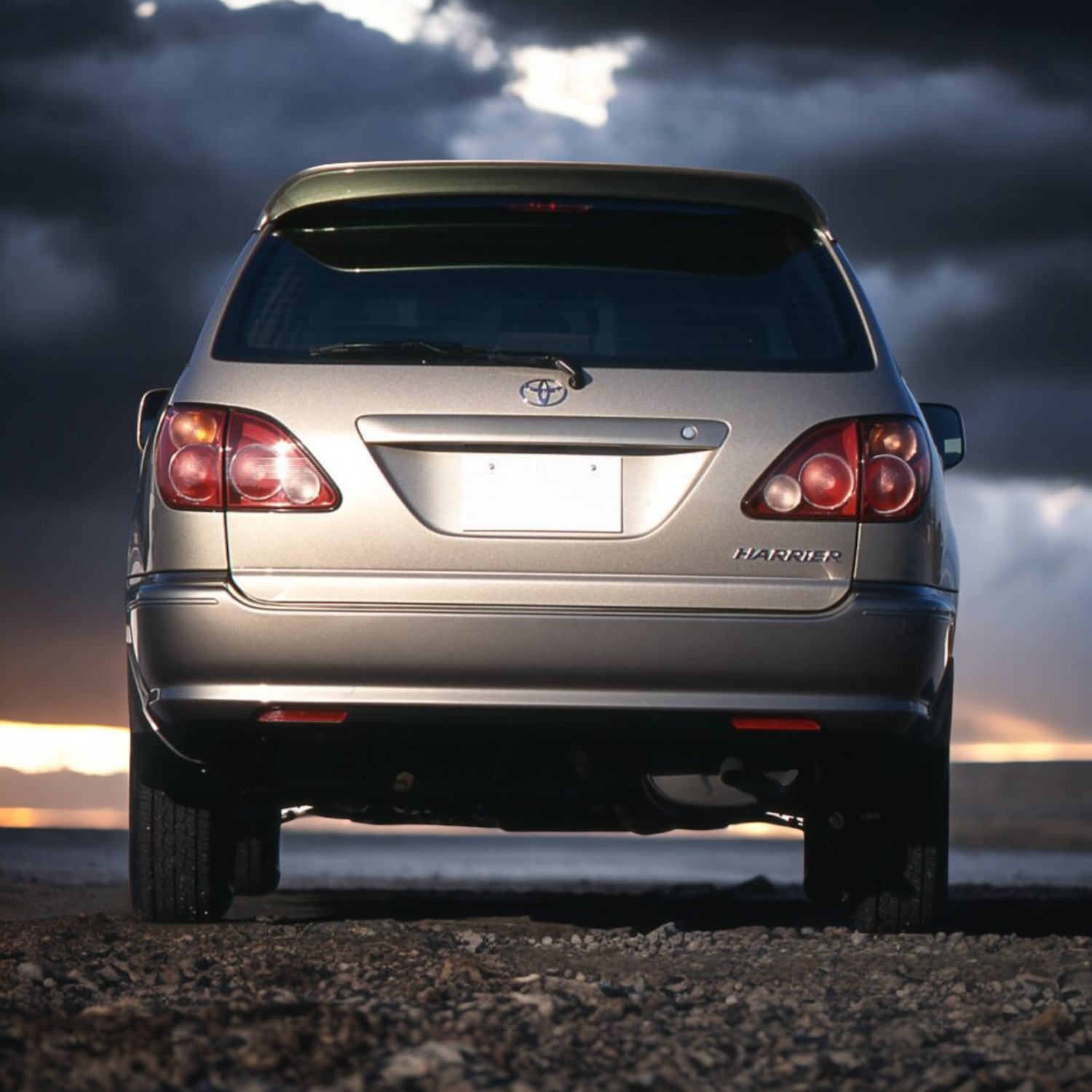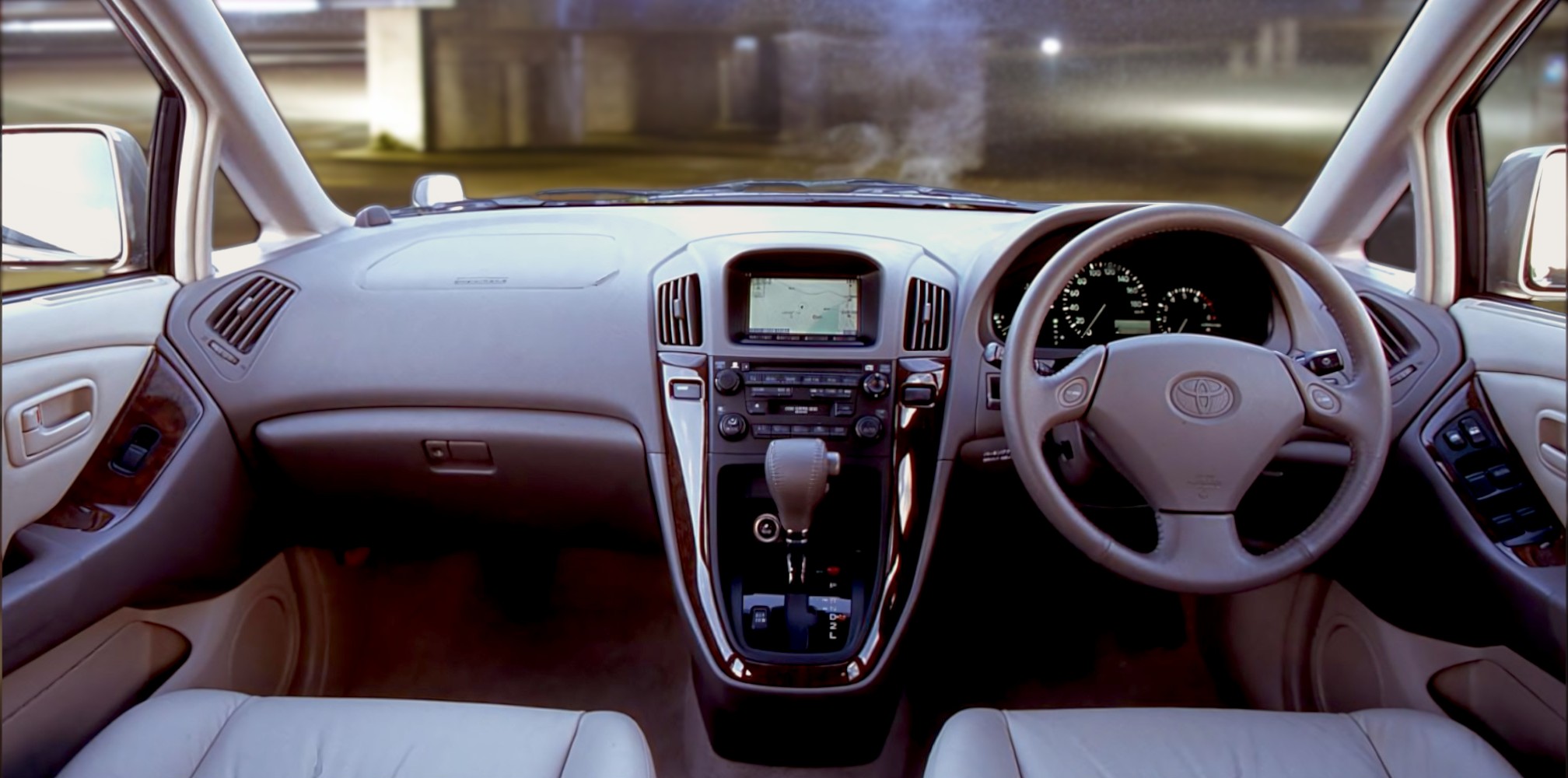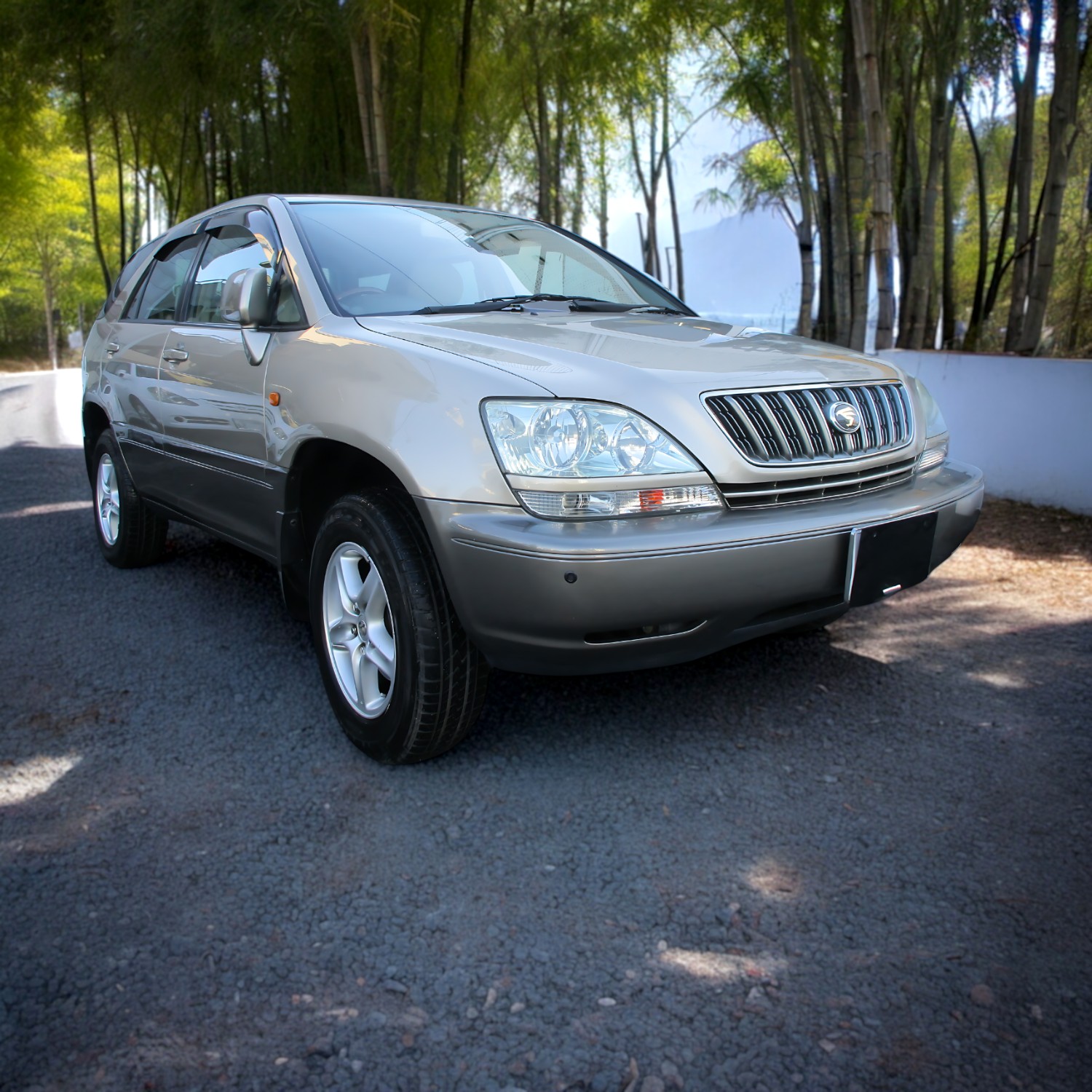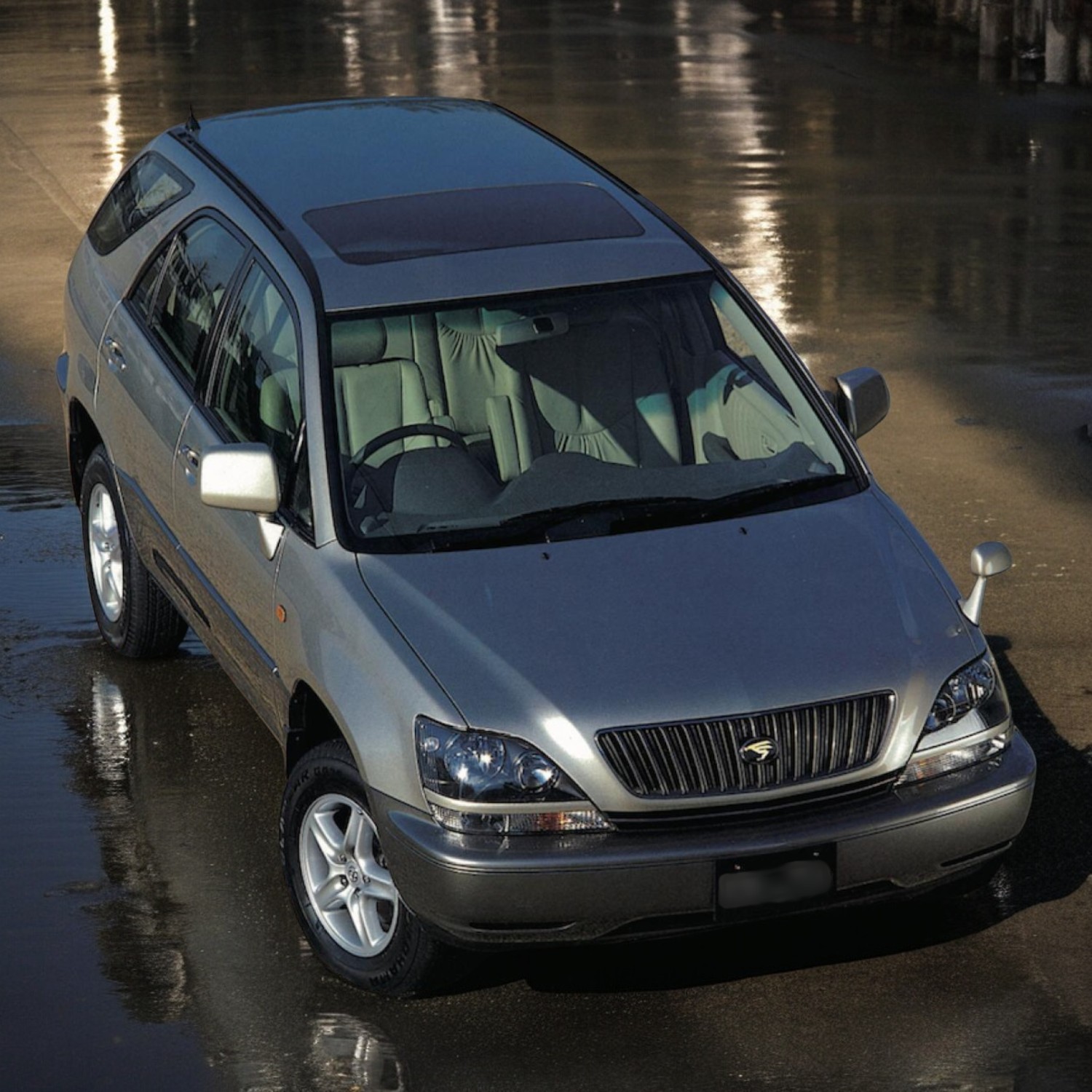Toyota Harrier
The RHD Toyota Harrier may be more familiar to you in its LHD form as the Lexus RX. This SUV is the perfect combination of quality, durability and comfort for hard-working rural letter carriers in the USA.
Jump To Section
Introduction To The RHD Toyota Harrier
The right-hand drive Toyota Harrier was a pioneering model in the crossover SUV segment, making its debut in December 1997. Designed by Toyota’s Chief Engineer, Yukihiro Okane, the Harrier was built on the reliable 6th generation Toyota Camry platform with the goal of merging the ruggedness of an SUV with the luxury and comfort of a sedan. Now we’re used to this concept with crossover SUVs, but at the time, it was a new idea. This innovative design catered to consumers needing both off-road abilities and refinement. The Harrier’s blend of utility and luxury set it apart in the market and it quickly gained popularity in Japan. The first generation Harrier was on sale in Japan from 1997 until very early 2003.
Now, as a US rural postal carrier, you’ll be familiar with the right-hand drive Toyota Harrier because it was sold in LHD form as the Lexus RX in the United States. The Lexus brand image of reliable comfort definitely has a strong appeal when you need a work vehicle that won’t let you down, but which is also a comfortable ‘office’ for those hours you spend delivering every day. It’s tough, has that Toyota/Lexus reliability, but isn’t so hardcore that you don’t want to spend much time in it. That’s the RHD Toyota Harrier.


History and Development
Background and Inspiration
The Toyota Harrier was conceived in the mid-1990s when Toyota recognized the emerging market for luxury SUVs. The success of the Toyota Camry and the growing popularity of SUVs inspired Toyota with an idea – to build a vehicle that would combine the best features of both segments. Led by Chief Engineer Yukihiro Okane, the development team aimed to produce what we now know as a crossover SUV – one that offered the refinement of a luxury sedan with the versatility and durability of an off-road vehicle.
Initial Launch and Market Reception
The Toyota Harrier made its official debut in December 1997, initially available only in the Japanese domestic market. The launch event was held with much fanfare, showcasing the Harrier’s sleek design, luxurious interior, and advanced technology. Toyota pushed the combination of refinement and off-road abilities with their marketing slogan “Wild but Formal”, and chose the name ‘Harrier’ as this is a bird of prey that embodies power, speed, and agility The market reception was overwhelmingly positive. Toyota’s genre-combining gamble had paid off.
Within its first year, the Harrier became a best-seller in its segment, attracting a wide range of buyers from young professionals to families. Having conquered Japan, Toyota decided to introduce it into other markets, including North America, where it was sold as the Lexus RX.
Harrier Design and Engineering Goals
The design and engineering goals for the Toyota Harrier were ambitious. Some of the key goals included:
- Versatile Platform: Built on the reliable 6th generation Camry platform, the Harrier was designed to offer a smooth and stable ride while accommodating the higher ground clearance needed for an SUV.
- Luxurious Interior: The Harrier’s interior was crafted to provide a high level of comfort and sophistication. Features included high-quality materials, ergonomic seating, and advanced infotainment systems.
- Advanced Safety Features: Toyota prioritized safety by incorporating safety features that were cutting-edge for the time, such as dual front airbags, anti-lock braking system (ABS), and side-impact protection.
- Power and Performance: The Harrier came with different engine options, including a 2.2-liter 4-cylinder and a 3.0-liter V6, designed to deliver strong performance with decent fuel efficiency.
- Aerodynamic Design: The exterior design of the Harrier focused on aerodynamic efficiency, with smooth lines and a sleek profile, reducing drag while setting it apart from boxy SUVs.
The Lexus mindset was also evident in the Harrier’s engineering that focused on reducing noise, vibration, and harshness (NVH) levels to ensure a quiet, restful driving experience.
Models and Variants (1997-2000)
Overview of Different Models (SXU, ACU, MCU1)
The first-generation Toyota Harrier, produced from 1997 to 2000, came in several variants, each identified by different model codes: SXU, ACU, and MCU1 that denoted different engine configurations and drivetrains.
- SXU Models: These models were equipped with the 2.2-liter 5S-FE inline-4 gasoline engine. These SXU models were the entry-level variants, offering a balanced mix of performance and efficiency. They were primarily front-wheel drive, making them ideal for urban commuting where off-road prowess, or the need to deal with harsh weather conditions, was not a priority.
- ACU Models: The ACU models featured the 2.4-liter 2AZ-FE inline-4 gasoline engine. Introduced later, this engine offered slightly more power and improved fuel efficiency compared to the 5S-FE unit. The ACU models were available in both front-wheel drive and four-wheel drive configurations.
- MCU Models: These were the top-tier variants, powered by the 3.0-liter 1MZ-FE V6 engine. These were also available as both front-wheel drive and four-wheel drive variants.

Differences Between Harrier Variants
The differences between the SXU, ACU, and MCU RHD Toyota Harrier models extended beyond just their engines. The 2.4 liter ACU models replaced the 2.2 liter SXU models in 2000. Here are some of the key distinctions:
- Performance: The MCU1 models, with their 3 liter V6 engines, offered the highest power output, whereas the SXU and ACU models were more focused on efficiency and affordability.
- Drivetrain Options: All variants were available in both front-wheel drive and 4WD.
- Features and Trim Levels: The MCU models typically came with more luxurious features, such as leather seats, advanced infotainment systems, and higher-quality interior materials. The SXU and ACU models, while still well-equipped, had fewer of those premium features to keep costs lower.
Yearly Updates and Changes (1997-2000)
1997
- Launch: The Toyota Harrier was introduced in December 1997. Initially, it was available with two engine options: a 2.2-liter 5S-FE inline-4 engine and a 3.0-liter 1MZ-FE V6 engine. The 5S-FE engine variants were front-wheel drive, while the V6 variants offered both front-wheel drive and four-wheel drive configurations.
1998
- Special Edition: In June 1998, Toyota introduced the “Harrier Zagato,” a special edition model in collaboration with the Italian design house Zagato. This model featured unique styling elements such as special aluminum wheels and fender flares. It was based on the V6 models.
- New Engine Introduction: The 2.4-liter 2AZ-FE inline-4 engine was introduced in 2000, replacing the 2.2-liter 5S-FE engine. This new engine provided better power output and fuel efficiency. Additionally, the VVT-i (Variable Valve Timing with intelligence) technology was incorporated in both the 2.4-liter and 3.0-liter engines to enhance both performance and efficiency.
- Safety and Lighting Updates: Discharge (HID) headlamps with auto-leveling were introduced, significantly improving nighttime visibility and driving safety.
2000
- Facelift and Additional Updates: In November 2000, the JDM RHD Toyota Harrier underwent a significant facelift. This included further exterior updates to the headlights and grille. Interior enhancements, such as new aluminum trim, UV-cut privacy glass, and rear seat heaters, were also introduced.
- Increased Fuel Tank Capacity: The fuel tank capacity was increased from 65 liters to 75 liters for greater driving range.
- Other Updates: These included the introduction of Vehicle Stability Control (VSC) as an option on the 3.0-liter models, the standardization of Brake Assist across all models, and an updated DVD navigation system.


Harrier Key Features
Engine Options and Performance
The first-generation Toyota Harrier offered three primary engine options over its production run from 1997 to 2000:
- 2.2-liter 5S-FE Inline-4: This engine delivered 140 PS (138 horsepower) at 5,600 RPM and 191 Nm (141 lb-ft) of torque at 4,400 RPM. It was available in the front-wheel-drive configuration and was known for its balance between performance and fuel efficiency.
- 3.0-liter 1MZ-FE V6: The more powerful option, this V6 engine produced 220 PS (217 horsepower) at 5,800 RPM and 304 Nm (224 lb-ft) of torque at 4,400 RPM. This engine was available in both front-wheel-drive (MCU10W) and four-wheel-drive (MCU15W) configurations.
- 2.4-liter 2AZ-FE Inline-4: Introduced in 2000, this engine provided 160 PS (158 horsepower) at 5,600 RPM and 221 Nm (163 lb-ft) of torque at 4,000 RPM. It offered improved power and fuel efficiency compared to the 2.2-liter engine and was available in both front-wheel-drive (ACU10W) and four-wheel-drive (ACU15W) configurations
Fuel Efficiency
The fuel efficiency of the Toyota Harrier varied based on the engine, drivetrain, and driving conditions:
- 2.2-liter Engine: Approximately 22 mpg in urban driving and up to 42 mpg on the highway.
- 3.0-liter Engine: Approximately 22 mpg in urban driving and up to 39 mpg on the highway.
Interior and Comfort Features
The Toyota Harrier was designed with a focus on comfort and luxury, offering features that were ahead of its time:
- Interior Space: The Harrier boasted an interior length of 78 inches, a width of 59 inches, and a height of 47 inches, creating a comfortable and airy space for passengers.
- Standard Features: Power windows, power steering, a rev counter, central door locking, keyless entry, adjustable steering wheel, wood panel trim, and climate control were standard.
- Optional Features: Leather seats, power-adjustable seats, and a DVD-based navigation system were available as options. Additionally, UV-cut privacy glass and rear seat heaters were additional options on some models.
Cargo Capacity
The cargo capacity of the Toyota Harrier was designed to be practical for a variety of uses:
- Rear Seats Up: With the rear seats up, the cargo capacity was approximately 40 cubic feet.
- Rear Seats Down: Folding the rear seats increased the cargo capacity to approximately 75 cubic feet.
Safety Features
Safety was a significant focus for the RHD Toyota Harrier:
- Standard Safety Features: Dual front airbags, side impact bars, safety belt pretensioners, three-point safety belts for all seats, and child car restraints were standard.
- Optional Safety Features: Side airbags, Vehicle Stability Control (VSC) for improved stability in adverse conditions, and Brake Assist for enhanced emergency braking performance were available.
- Advanced Lighting: The Harrier also featured discharge (HID) headlamps with auto-leveling on higher trims, significantly improving nighttime visibility.
Comparison with Competitors
In the competitive Japanese SUV market, the Toyota Harrier stood out against rivals such as the Mitsubishi Pajero and Nissan Terrano. While these competitors definitely offered strong off-road capabilities, the Harrier stood apart with its luxurious features and its car-like driving experience. Key advantages also included the powerful yet smooth 3.0-liter V6 engine, advanced safety features like Vehicle Stability Control (VSC) and Brake Assist, and its stylish, comfortable interior.


Maintenance and Reliability
Common Maintenance Tasks
Maintaining a first-generation Toyota Harrier involves several routine tasks that will help it to keep on running:
- Oil Changes: Regular oil changes are crucial. Typically, it is recommended to change the engine oil every 5,000 to 7,500 miles.
- Brake Maintenance: Brake pads and rotors should be inspected regularly.
- Tire Rotation and Replacement: Tires should be rotated every 6,000 miles to ensure even wear and inspected regularly for wear. Winter tires should be fitted if you’re in an area that has a lot of snowfall.
- Filter Replacements: Air and fuel filters should be replaced to keep that Toyota engine running smoothly.
Long-Term Reliability and Durability
The Toyota Harrier is known for its long-term reliability and durability. Key factors contributing to its great reputation include:
- Engine Reliability: The 2.2-liter 5S-FE and 3.0-liter 1MZ-FE engines are renowned for their durability. With proper maintenance, these engines can easily surpass 200,000 miles without major issues.
- Build Quality: Given its subsequent metamorphosis into the North American Lexus RX, it will be no surprise that the Harrier’s build quality is another of its strong points. The use of high-quality interior materials convey that sense to the driver and passengers.
Availability of Parts and Ease of Maintenance
Parts for the first-generation Toyota Harrier are readily available, both from Toyota dealerships and aftermarket suppliers. Key points include:
- Parts Availability: Given it’s connection to the LHD Lexus RX sold in the US, the first generation Toyota Harrier has many common parts.
- Ease of Maintenance: The Harrier’s design allows for relatively straightforward maintenance procedures. Many routine tasks, such as oil changes and filter replacements, can be performed easily by a skilled mechanic or even by owners with basic mechanical knowledge. For more tricky procedures, mechanics already familiar with the Lexus RX should have no problem figuring out what needs to be done.
Japanese Owners’ Experiences
In online reviews, owners of the first-generation Toyota Harriers shared overwhelmingly positive experiences, highlighting the vehicle’s reliability, performance, and even the emotional bonds they developed with it.
For example, one owner, who has had their Harrier for over 23 years, described how the vehicle has driven 118,000 miles in that time without any major issues or breakdowns. This owner clearly loves their Harrier, as they compared it to a pet they couldn’t part with.
Another long-term owner, with 15 years of experience, reported a completely trouble-free ownership. They gave it high ratings across multiple categories including exterior design, interior comfort, engine performance, driving dynamics, and overall value. The only area they said they would like to see improvement was fuel efficiency. Despite this minor drawback, this owner’s overall rating was still high.
Conclusion
Although Lexus may not be the first manufacturer to spring to mind when you’re considering getting a right-hand drive vehicle for your postal route, these Toyota Harriers (being basically RHD Lexus RXs) can be a great choice – they’re robust with that Toyota / Lexus build quality, they drive well and are very comfortable, and they have more than adequate hauling capacity for all those letters and parcels.
Specifications & Details
General Information
- Model Years: 1997-2000
- Manufacturer: Toyota
- Assembly: Toyota Motor Kyushu, Japan
Dimensions
- Overall Length: 179.9 inches
- Overall Width: 71.5 inches
- Overall Height: 65.6 inches
- Wheelbase: 102.8 inches
- Curb Weight: 3,505 – 3,814 lbs (depending on the model)
Engine Options
- 2.2-liter 5S-FE Inline-4 (SXU10W & SXU15W models)
- Displacement: 2,184 cc
- Power Output: 140 PS (138 hp) @ 5,600 RPM
- Torque: 191 Nm (141 lb-ft) @ 4,400 RPM
- 2.4-liter 2AZ-FE Inline-4 (ACU10W & ACU15W models)
- Displacement: 2,362 cc
- Power Output: 160 PS (158 hp) @ 5,600 RPM
- Torque: 221 Nm (163 lb-ft) @ 4,000 RPM
- 3.0-liter 1MZ-FE V6 (MCU10W & MCU15W models)
- Displacement: 2,995 cc
- Power Output: 220 PS (217 hp) @ 5,800 RPM
- Torque: 304 Nm (224 lb-ft) @ 4,400 RPM
Transmission
- Type: 4-speed automatic transmission (4AT)
Drivetrain
- Configurations: Front-wheel drive (FF) and Four-wheel drive (4WD)
Suspension
- Front: MacPherson strut
- Rear: Strut
Brakes
- Front: Ventilated disc
- Rear: Disc

